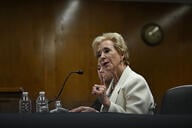You have /5 articles left.
Sign up for a free account or log in.
House Republicans who want to stop President Biden’s student loan policies used a hearing Thursday to outline why they think those policies are harmful to the economy and what changes they would prefer.
Utah representative Burgess Owens, a Republican who chairs the House Higher Education and Workforce Development Subcommittee, focused his first hearing of the new Congress on examining the implications of the Biden administration’s student loan policies for students and taxpayers. The hearing showed the divides between Republicans and Democrats on the subcommittee on student loan issues and higher education more broadly.
“The Biden administration proposal is a patchwork attempt to fix a structural problem that will only make worse the issues of rising prices and low-quality educations—it is one that leaves students worse than if they had never enrolled in the first place,” Owens said.
He added that the hearing also would “present an alternative vision that will lower college costs, limit excessive borrowing, and ensure students and taxpayers get a return on their investment in postsecondary education.”
A key part of that vision appears to be some risk-sharing provision that would require colleges and universities to be financially liable for student loans in the event that a borrower doesn’t repay their loan, according to the queries at the hearing. Higher education associations have historically opposed risk-sharing measures.
Owens said the colleges that have “no skin in the game” are the only ones that benefit from the student debt crisis.
“They push out programs that mean absolutely nothing for the children that come through,” he said. “Children come out in debt and hating their country and not understanding the free market system or loving the process that gave them the opportunities they had. We’ve heard a lot of attacks on for-profits. It’s not for-profits that got us into the problem today. We need to have solutions. We’re at a point now where we need innovative disruptions.”
The Biden administration has embarked on a wide-ranging plan to shore up the federal loan system, which includes closing loopholes, changes to the Public Service Loan Forgiveness program, new borrower defense to repayment regulations and a new income-driven repayment plan. The centerpiece of the student loan policies is the one-time student loan forgiveness, which is currently being challenged by six states and a pair of Texas residents in the Supreme Court. A decision in that case on the legality of the plan is expected later this spring.
The three witnesses called by Republicans said the Biden administration’s policies, which include a pause on student loan payments that’s been in place since March 2020 and one-time forgiveness of up to $20,000 for eligible Americans, would stoke inflation, increase the cost of college and lead to more borrowing among students and worse outcomes.
“At best it’s a temporary Band-Aid,” said Marc Goldwein, senior policy director for the Committee for a Responsible Federal Budget. “It’s more likely to worsen structural problems.”
Adam Looney, an economist who leads the Marriner S. Eccles Institute for Economics and Quantitative Analysis at the University of Utah, said other changes were needed to address the fundamental problems that caused the student loan crisis.
“Useless degree programs and exorbitant costs can’t be solved by encouraging students to take out loans,” he said.
Carlo Salerno, education economist and an independent consultant, said there’s “no reason to think the costs won’t continue to rise without checks or guardrails,” when asked about the effect the student loan policies could have on the average cost of postsecondary education.
Sameer Gadkaree, president of the Institute for College Access and Success and the witness called by Democrats on the committee, outlined how the administration’s policies would support borrowers and called on Congress to lower college costs and double the maximum Pell Grant award so students wouldn’t have to borrow money to attend college.
“The administration’s student loan actions help address the most serious consequences of rising student debt,” he said.
Student borrower advocacy groups criticized the hearing for failing to include the voices of borrowers.
Republican representatives used their time, generally, to criticize the administration’s plans, signal support for risk-sharing and ask about inflation and outcomes. In one exchange, Wisconsin representative Glenn Grothman, a Republican, said the Pell Grant’s current eligibility criteria are “a slap in the face to middle-class America” and the program is “inexcusable.”
Democratic lawmakers voiced their support for the Biden administration’s policies, drew attention to the drop in state funding for public colleges and universities, and highlighted the decline in the Pell Grant’s value, which covers less than about 30 percent of the cost to attend a four-year public college, on average.
Florida representative Frederica Wilson, the top Democrat on the subcommittee, said the criticism of the debt-relief plan reflects a double standard “that speaks volumes to our values.” She compared the debt-relief plan to bailouts of corporations and the auto industry.
“When we decided to bail out the students, all hell breaks loose and the whining turns to outrage,” she said.
She pointed to the recently introduced Lowering Obstacles to Achievement Now (LOAN) Act as a blueprint for how Democrats would address the issues in the student loan system and lower the cost of college. That act would authorize a doubling of the maximum Pell Grant award, make loans less expensive and lower interest rates.
In her closing remarks, she said that she looked forward to working with Owens to help students.
“We are just beginning,” she said.




